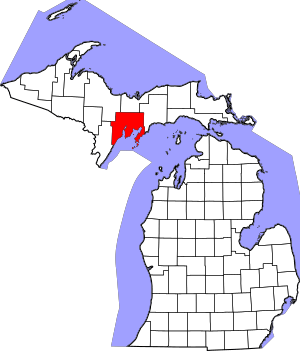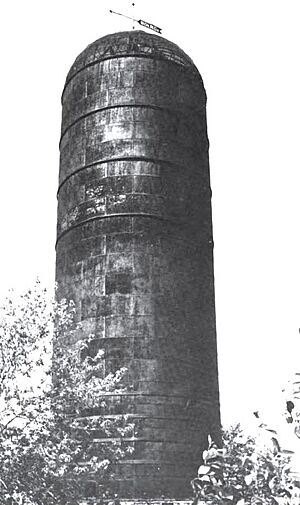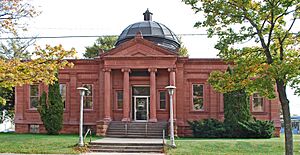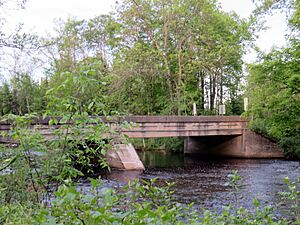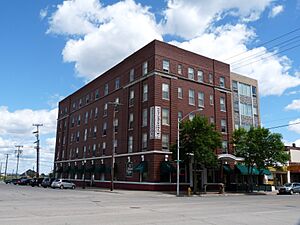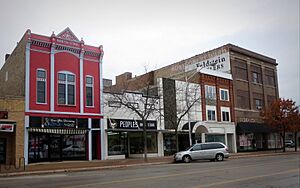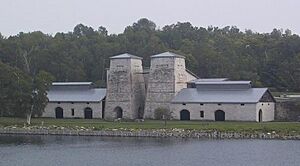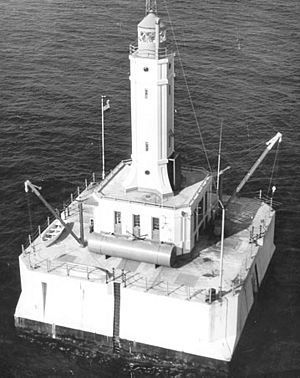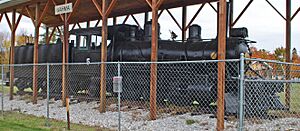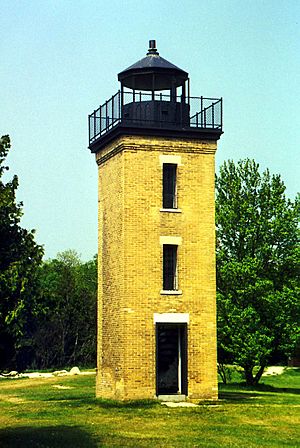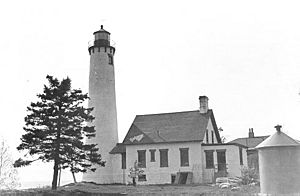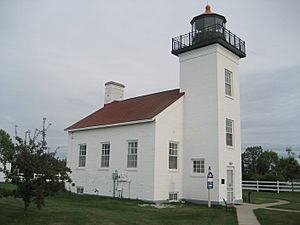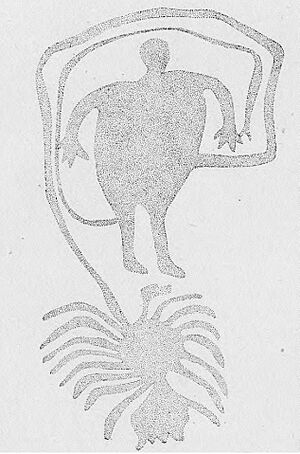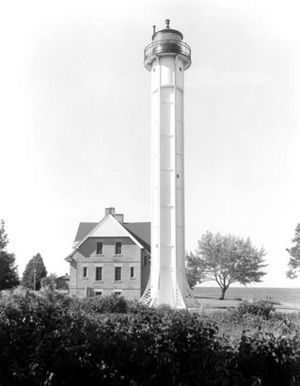National Register of Historic Places listings in Delta County, Michigan facts for kids
This page lists special places in Delta County, Michigan, that are part of the National Register of Historic Places. This is a list of buildings, areas, and objects that are important to history. They are officially recognized by the United States government.
You can find 19 of these special places in Delta County. They are all important parts of Michigan's history!
Contents
- Historic Places in Delta County
- Bay de Noquet Lumber Company Waste Burner
- Carnegie Public Library (Escanaba)
- County Road I-39 – Rapid River Bridge
- Delta Hotel
- Escanaba Central Historic District
- Fayette Historic State Park
- Gooseneck Lake III Site
- Gooseneck Lake IV Site
- Jackpine Lake Site
- Minneapolis Shoal Light Station
- Nahma and Northern Railway Locomotive No. 5
- Peninsula Point Lighthouse
- Poverty Island Light Station
- Richter Brewery
- Sand Point Lighthouse
- Spider Cave
- St. Martin Island Light Station
- Summer Island Site
- Winter Site
Historic Places in Delta County
Bay de Noquet Lumber Company Waste Burner
This tall, round tower was built between 1888 and 1893. It's about 100 feet (30 meters) tall and 32 feet (10 meters) wide. It's made of cast iron plates and lined with bricks. The Bay de Noquet Lumber Company used it to burn wood waste from their sawmill. It helped them get rid of leftover wood pieces.
- Location: South end of River Street, Nahma Township
- Listed: April 8, 2011
Carnegie Public Library (Escanaba)
The Escanaba Carnegie Public Library was built in 1902. Andrew Carnegie, a famous businessman, donated $20,000 to build it. It's a one-story building made of red brick and sandstone. It looks like a classic Greek or Roman building. The library moved to a new spot in 1995. The old building was then sold and turned into a private home.
- Location: 201 South 7th Street, Escanaba
- Listed: July 25, 1977
County Road I-39 – Rapid River Bridge
This bridge was built in 1916. It crosses the Rapid River. It is the oldest example of a concrete girder bridge designed for Michigan's main road system. A concrete girder bridge uses strong concrete beams to support the road.
- Location: County Road I-39 over Rapid River, Masonville Township
- Listed: December 9, 1999
Delta Hotel
The Delta Hotel is a five-story building, about 66 feet (20 meters) tall. It opened in 1914. It has a classic architectural style. It was a hotel until 1962. Then, it became a home for senior citizens called the Bishop Noa Home. In 1992, the seniors' home moved out. The building was then fixed up. Now, it has a brewpub on the first floor and apartments on the upper floors.
- Location: 624 Ludington Street, Escanaba
- Listed: April 9, 1998
Escanaba Central Historic District
This historic area stretches for more than a mile along Ludington Street. This is the main street in Escanaba. The buildings in this district generally get newer as you go from east to west. This shows how the city grew over time. Some parts, like the House of Ludington, might be from the 1860s. Other smaller shops date back to the early 1900s.
- Location: Roughly 200-1800 blocks of Ludington Street, Escanaba
- Listed: April 7, 2014
Fayette Historic State Park
From 1867 to 1891, Fayette was a very busy place. It had the most successful iron smelting operation in Michigan's Upper Peninsula. Iron smelting is the process of getting iron from ore. Nearly 500 people lived in the town nearby. Today, the town has been rebuilt as a state park. It's like a living museum that shows what life was like in the late 1800s.
- Location: On a peninsula in Big Bay de Noc, on M-183 in Fayette State Park, Fayette
- Listed: February 16, 1970
Gooseneck Lake III Site
This is an archaeological site near Gooseneck Lake. Archaeological sites are places where people find old tools, buildings, or other things from the past. This site is part of a larger group of sites from the Woodland Period. The Woodland Period was a time when Native American cultures lived in this area.
- Location: Near Gooseneck Lake, Escanaba
- Listed: June 27, 2014
Gooseneck Lake IV Site
This is another archaeological site located near Gooseneck Lake. Like the Gooseneck Lake III Site, it is also from the Woodland Period. These sites help us learn about the ancient people who lived here.
- Location: Near Gooseneck Lake, Escanaba
- Listed: June 27, 2014
Jackpine Lake Site
This archaeological site is found near Jackpine Lake. It is also part of the Woodland Period Archaeological Sites. These sites are important for understanding the history of Native Americans in the region.
- Location: Near Jackpine Lake, Escanaba
- Listed: June 27, 2014
Minneapolis Shoal Light Station
This lighthouse was finished in 1934. It looks very similar to the Grays Reef Light Station, which was built around the same time. The Light Station sits on a strong concrete base that is 30 feet (9 meters) high. On top of this base is a two-story building. The first floor held equipment, and the second floor was where the lighthouse keeper lived. The lighthouse tower itself is 17 feet (5 meters) tall and sits in the middle of the building's roof.
- Location: In northern Green Bay, 6.6 miles (10.6 km) south of Peninsula Point
- Listed: November 15, 2006
Nahma and Northern Railway Locomotive No. 5
This train engine is a 2-6-2 coal-burning locomotive. It was built in 1912 by the Baldwin Company in Philadelphia. It ran on the Nahma and Northern Railway. This railway line was built by the Bay De Noquet Lumber Company in 1901. It went from Nahma into the nearby forests and to different lumber camps.
- Location: Main Street at River Street, Nahma Township
- Listed: January 30, 2007
Peninsula Point Lighthouse
The Peninsula Point Lighthouse was built in 1865. It sits at a key spot, guiding ships into Escanaba. The light was used until 1936, when the Minneapolis Shoal Light Station took over its job. The next year, the Civilian Conservation Corps helped fix up the building and create picnic areas for the public. Sadly, the attached house where the keeper lived burned down in 1956.
- Location: 6.5 miles (10.5 km) southeast of Escanaba in Hiawatha National Forest
- Listed: April 28, 1975
Poverty Island Light Station
The Poverty Island Light was built between 1873 and 1875. It was used until 1976, when a newer light was built nearby. This lighthouse has a white, cone-shaped tower. In the 1980s, the light's lantern was saved by the Delta County Historical Society. They used it to help fix up the Sand Point Light in Escanaba. The Poverty Island Lighthouse is still empty and needs repairs. In 2011, it was called "America’s Most Endangered Lighthouse."
- Location: Northwestern Lake Michigan, 5.8 miles (9.3 km) south of Garden Peninsula at Fairport
- Listed: September 6, 2005
Richter Brewery
This building was constructed in 1900 as the Richter Brewery. It was used to make beer until the Prohibition Era began. During Prohibition, it made non-alcoholic drinks. After Prohibition ended, it was sold to the Delta Brewery Company and renamed the Delta Building. They brewed beer there until 1940. After being empty for many years, the building was fixed up between 2008 and 2012. It is now called the Lofts on Ludington and has apartments.
- Location: 1615 Ludington Street, Escanaba
- Listed: April 15, 2009
Sand Point Lighthouse
The Sand Point Lighthouse was built in 1867-1868. It helped guide ships into Escanaba's harbor. This lighthouse is special because its tower faces the land instead of the water. No one knows if this was done on purpose or was a mistake. The light was active until 1939. After that, it was used as a home for United States Coast Guard sailors. In 1986, the Delta County Historical Society got the lighthouse and restored it.
- Location: 12 Waterplant Road, Escanaba
- Listed: December 1, 1997
Spider Cave
Spider Cave is a cave formed by water. It is about 20 feet (6 meters) above the base of Burnt Bluff, right on the shore of Big Bay de Noc. Inside the cave and near its entrance, you can see four pictographs. These are ancient drawings on the cave walls. Most of the old tools found here were broken spear points from the Middle Woodland period. This suggests they were shot into the cave and broke against the back wall.
- Location: At the base of Burnt Bluff, Fayette
- Listed: April 16, 1971
St. Martin Island Light Station
The St. Martin Island Light is a very special lighthouse. It has a unique "exoskeleton" design. An exoskeleton is like an outer skeleton. This lighthouse marks one of the four passages between Lake Michigan and Green Bay. The tower is shaped like a hexagon and is made of iron plates. These plates are held up by six outer steel posts with crisscross supports. Built in 1905, this is the only lighthouse of its kind on the U.S. side of the Great Lakes.
- Location: St. Martin Island, Fairport
- Listed: July 19, 1984
Summer Island Site
This site was probably used as a fishing spot in late summer by many Native American groups. This includes people from the Middle and Late Woodland periods, and even later groups after they met European settlers. The site is on a sandy field above Summer Harbor. It was used as a fishing village in late summer and early fall.
- Location: Near Summer Harbor on the northwest side of Summer Island
- Listed: September 3, 1971
Winter Site
The Winter Site is located near the Lake Michigan coast. It shows how people from the Middle Woodland period started to live in coastal areas during late fall and winter. This site helps us understand how these ancient people adapted to different seasons and environments.
- Location: On a small tributary of Big Bay de Noc, Garden
- Listed: May 19, 1976


